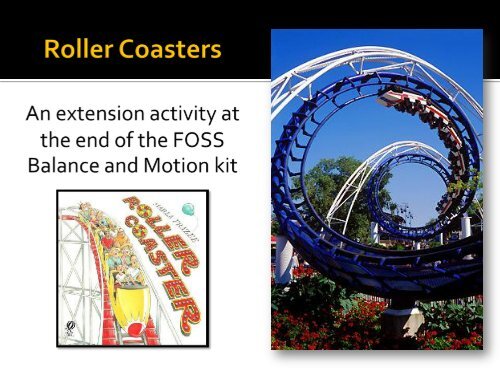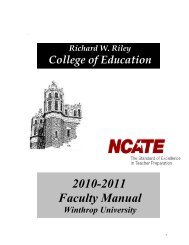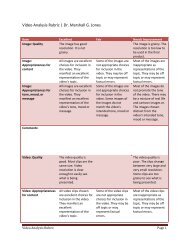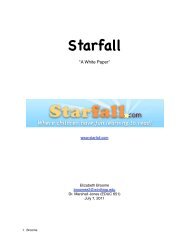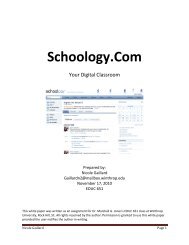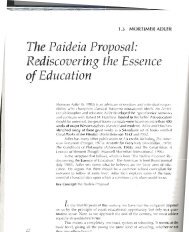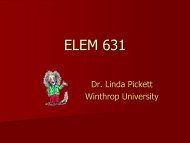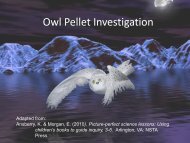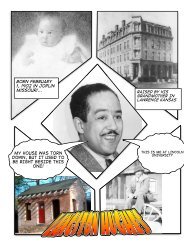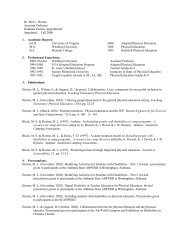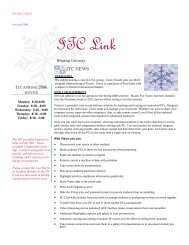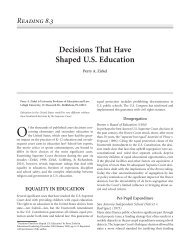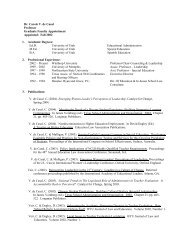Roller Coasters
Roller Coasters
Roller Coasters
Create successful ePaper yourself
Turn your PDF publications into a flip-book with our unique Google optimized e-Paper software.
Materials<br />
Runway<br />
Marble
Observe how the marble travels in the runway when it<br />
is in different positions.<br />
How can you make it go faster? Slower?<br />
What happens to the marble when it travels through a<br />
curve?<br />
Can you make the marble go through a loop?<br />
What happens to the marble when it travels through a<br />
loop?<br />
Students record their observations on the Marble<br />
Runways activity sheet (p. 168).
What were the features that made this a<br />
good roller coaster?
Materials:<br />
10 runways – do not cut!<br />
Masking tape<br />
Marble<br />
Cup<br />
Metersticks<br />
Stopwatch<br />
Calculator
Thrill rating – it must have at least 1 loop, 1 curve,<br />
and 1 drop. The more, the better!<br />
Safety rating – the marble has to make it into the<br />
cup placed at the end of the roller coaster.<br />
Your group will present an overview of the features of<br />
your roller coaster including the name and features;<br />
and then demonstrate it for the amusement park<br />
executives and insurance underwriters.
Speed = distance (cm)<br />
time (sec)<br />
We will record the speed on<br />
a class data table.
Let’s build a<br />
roller coasters!<br />
Please be<br />
ready to<br />
present your<br />
roller coaster<br />
at…
Group Distance (cm) Time (sec) Speed (d/t)<br />
1 633.5 cm 2.81 sec 225.44<br />
cm/sec<br />
2<br />
3 644 cm 3.8sec 169.5<br />
cm/sec
Standard 5-1: The student will demonstrate an<br />
understanding of scientific inquiry, including the<br />
foundations of technological design and the<br />
processes, skills, and mathematical thinking<br />
necessary to conduct a controlled scientific<br />
investigation.<br />
5-1.7 Use a simple technological design process to<br />
develop a solution or a product, communicating the<br />
design by using descriptions, models, and drawings.
K-4 Content Standard E: Science and Technology –<br />
Abilities of Technological Design (NSES, p.137-138)<br />
Identify a simple problem<br />
Propose a solution<br />
Implement proposed solutions<br />
Evaluate a product or design<br />
Communicate a problem, design, and solution<br />
5-8 Content Standard E: Science and Technology –<br />
Abilities of Technological Design (NSES, p. 165-166)
3-5.2 Compare the motion of common objects<br />
in terms of speed and direction.<br />
3-5.3 Explain how the motion of an object is<br />
affected by the strength of a push or pull and<br />
the mass of the object.<br />
3-5.4 Explain the relationship between the<br />
motion of an object and the pull of gravity.
5-5.1 Illustrate the affects of force (including<br />
magnetism, gravity, and friction) on<br />
motion.<br />
5-5.2 Summarize the motion of an object in<br />
terms of position, direction, and speed.<br />
5-5.3 Explain how unbalanced forces affect the<br />
rate and direction of motion in objects.
The<br />
Millennium<br />
Force
First continuous-circuit roller coaster<br />
higher than 400 feet<br />
First roller coaster to reach 120 mph<br />
Highest drop of any roller coaster
Creating the design<br />
Collecting the data<br />
Analyzing the data<br />
Social Skills<br />
Works cooperatively in group<br />
Participates without dominating<br />
Stays on task
Modern<br />
Family<br />
Sophia Vergara<br />
filming an<br />
episode of<br />
Modern Family<br />
on location at<br />
Splash<br />
Mountain,<br />
Disneyland<br />
(Notice the<br />
high heels in<br />
her hands!)
http://www.fossweb.com/modulesK-2/index.html<br />
www.learner.org/exhibits/parkphysics/<br />
coaster/


